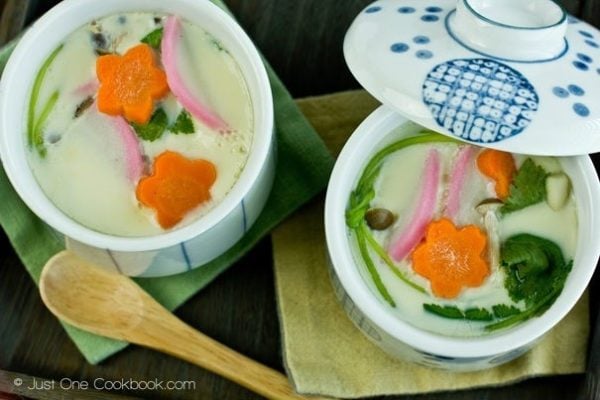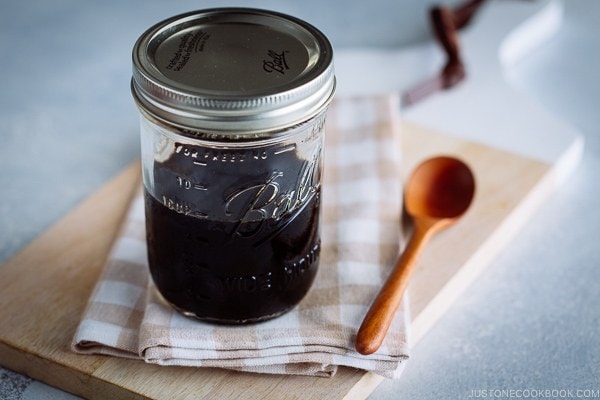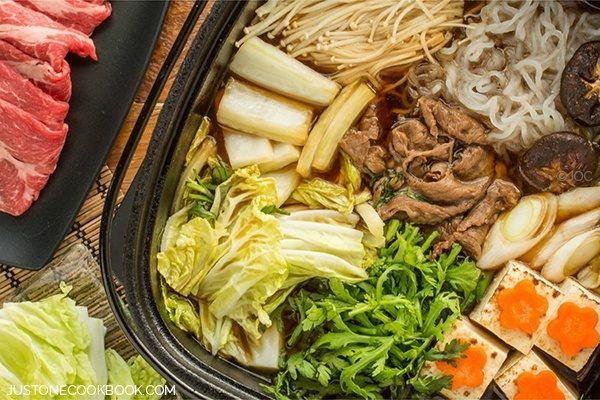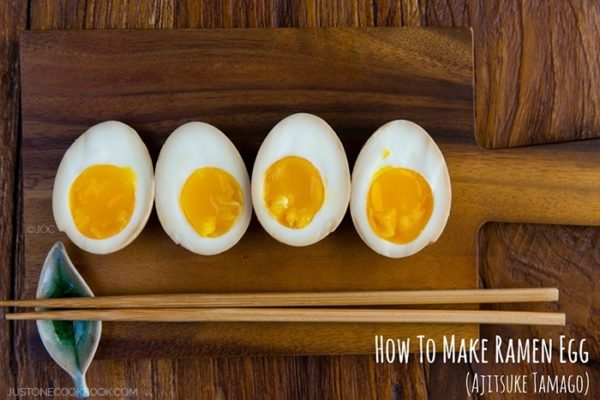New to Japanese cooking? Read on to learn more about sake and mirin, the two essential condiments used in Japanese cuisine.
Take a quick glance at Japanese recipes, you’ll find two Japanese pantry staples that are indispensable amongst them – sake and mirin. From teriyaki chicken to chawanmushi to sukiyaki, sake and mirin are often used together in making these delicious Japanese dishes that you’re already familiar with.
But what exactly are the differences between sake and mirin? What do they taste like? Why are they important in Japanese cooking? Can you substitute them with other ingredients? Today we’re going to talk about sake and mirin, their uses, substitutions, and how you can cook with them in general.
What is Sake?
Sake 酒, pronounced as SAH-keh, not saki, is made from rice and water. Although it is commonly referred as Japanese rice wine, it is made through a brewing process similar to beer, where the rice starch is converted to sugars which ferment into alcohol by yeast. Japanese use sake for cooking, just like how you would use wine for cooking.
Benefits of Cooking with Sake
- use in marinades to remove any odor of meat and fish
- tenderizes meat with its moisture
- adds umami and naturally sweet flavor to soup stocks, sauces, simmered and grilled dishes
- use as a key flavoring to a dish just like wine
- use to enhance, intensify and accent the overall flavor and aroma of a dish
- because sake is a fermented product which contains antioxidants, cooking with sake also offers you some great health benefits
Types of Sake for Cooking
Similar to white wine, there are many varieties of sake available, where they can be characterized from dry to sweet, and from delicate to robust. There are more expensive bottles for drinking, but you can use inexpensive bottles just for cooking.
What Can I Substitute for Sake in Recipes?
The closest substitution for sake is dry sherry or Chinese rice wine.
If you cannot consume alcohol, you can replace it with water or broth when a recipe calls for sake for steaming or making a sauce.
To learn more about sake, click here.
What is Mirin?
Mirin, also known as sweet Japanese rice wine, is a syrupy liquid that is used as a seasoning and glazing agent. It is a type of rice wine similar to sake, but with a lower alcohol and higher sugar content. The alcohol content usually ranges from 1% to around 14%. Therefore, it easily burns off during the cooking process.
Mirin has a sweet flavor, which makes it a nice contrast when used with saltier sauces, like soy sauce or tamari.
Types of Mirin for Cooking
In general, there are 4 types of mirin: hon mirin (“real” mirin, 本みりん), mirin (みりん), mirin-like condiment (みりん風調味料), and mirin-type condiment (みりんタイプ調味料). Hon mirin are usually imported and can be expensive. Mirin-like or mirin-type condiments are cheap and widely available, but they do contain more sugar and some additives.
To learn more about the different types of mirin, click here.
Benefits of Cooking with Mirin
- adds a mild sweetness to dishes
- helps tenderize meat
- helps to mask any dishes with strong fishy and gamey taste
- helps the flavors to better absorbed into the dish.
- adds luster and a nice glaze to dishes
What Can I Use to Substitute Mirin?
Although it won’t be exactly the same, you can substitute mirin with sake and sugar. The ratio of sake and sugar should be 3 to 1. For example, for 1 tbsp drinking sake, mix with 1 tsp of granulated sugar.
If you cannot use alcohol in your cooking for religious or other reasons, you can mix water with sugar in replace of sake.

<1% and no-alcoholic Mirin
Any Halal Substitute for Mirin?
Look out for Honteri Mirin by Mizkan which contains no alcohol.
Or you can substitute mirin with water and sugar. The ratio of water and sugar should be 3 to 1. For example, for 1 tbsp water, mix with 1 tsp of granulated sugar.
Differences Between Sake & Mirin
Although both sake and mirin are alcoholic products, mirin is only used mainly for cooking whereas sake can be used for both drinking and cooking. Both are frequently used hand in hand in a recipe for Japanese cooking. One of the main differences is sake contains higher alcohol and lower sugar contents, while mirin has a higher sugar content and lower alcohol content.
Sake is often added earlier in the cooking process to allow some of the alcohol to evaporate. It should simmer with the food to let is absorb with the flavors. If added too late in the cooking, you will end up with a harsh flavor. On the other hand, mirin can be used untreated in a dish or added at the end of the cooking process as a glazing agent to the dish.
Can I Substitute Sake & Mirin with Rice Vinegar?
The short answer is NO. You may find some websites or online forums that suggest rice vinegar to replace sake and mirin. However, part of the confusion is that rice vinegar is sometimes labeled as rice wine vinegar.
While the three products are made from fermented rice, the processes are different, which result in very different flavor profiles. Rice vinegar or rice wine vinegar has a strong acidity and sour flavor. That is why we do not recommend it as a replacement for sake or mirin.
Can I Skip Sake and Mirin Altogether?
For the occasional cooks, we understand why you may think of skipping the use of additional condiments. However, skipping these important ingredients will only result in lack-luster foods that can be disappointing. Each ingredient plays an important role in flavoring a dish, therefore it’s important to utilize them or at least replace them with the suggested substitutions.
Where Can I buy Sake & Mirin?
If you are in the US, you will be able to find drinking sake from a well-stocked liquor store. You can also find them from Japanese grocery store or Asian grocery store that have an alcohol license. For cooking sake, you may be able to find them at the Asian aisle in your local grocery store or online at Amazon. As for mirin, you can but it from Japanese grocery stores, Asian supermarkets, or Amazon.
Here is a master list of Japanese Grocery Stores Around the World contributed by our readers which we hope will be useful for you when looking for Japanese ingredients.
Delicious Recipes You Can Make with Sake & Mirin
Now that you’re convinced to get a bottle of sake and mirin for your pantry and wondering how you can cook with them, here are some fantastic Japanese recipes to get you started. Once you start venturing more into Japanese cooking, we promise you will soon enjoy using the two ingredients in creating many more dishes to come.
How to make authentic homemade teriyaki sauce with mirin and sake.
Make delicious broth with mirin and sake for this steamy Sukiyaki hot pot.
Use sake as one of the key flavorings in this fun Salted Chicken Wings (Teba Shio) recipe.

Learn how to make your favorite Japanese appetizer, Chawanmushi (Japanese Steamed Egg Custard), with mirin and sake.
Wondering how to make the soft custardy ramen eggs to top your noodles? Here is the recipe that will put that bottle of mirin to great use.
Teriyaki Salmon flavored with soy sauce, mirin, sake, and sugar. This is a must-keep recipe for your easy weeknight meals.

Originally from Penang, Malaysia, Reese lives in Minnesota with her husband and their baby boy. She previously ran an Asian spice shop, and also worked on UNESCO Heritage projects in Penang in the areas of performing arts, history, and arts education. Reese loves spending time with her family, listening to podcasts, and reading up on art & design. And of course, dreaming of another trip to Japan to hike mountain trails and eat her favorite street food Okonomiyaki. More from Reese →
The post Japanese Pantry Essentials: Sake vs Mirin appeared first on Just One Cookbook.








